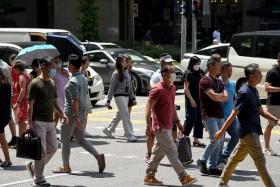Employment rate of Singapore citizens up
Share of PMETs among working S'poreans also went up in last 10 years: Report
The employment rate of Singapore citizens has risen over 10 years, along with the share of professionals, managers, executives and technicians (PMETs) among working Singaporeans.
Their real median income, which takes into account inflation, has also risen faster than that of the total resident workforce, which includes permanent residents (PRs).
Citizen unemployment, meanwhile, has remained low.
New figures on these trends were released by the Ministry of Manpower (MOM) yesterday in an occasional paper on citizens in the labour force.
As citizens make up about 85 per cent of the resident labour force, their trends track closely those of resident data, MOM said in the report based on data from June 2009 to June last year.
There were 2.33 million residents in the labour force as of June last year, comprising 1.97 million Singaporeans and 360,000 PRs.
Employment outcomes for citizens may be slightly lower than those of the wider resident population because people usually have to show good employability to get PR status, said the ministry.
The citizen employment rate rose to 63.6 per cent last year, up from 60 per cent year in 2009, driven by workers aged 65 and older.
Meanwhile, the residents' rate remained within 1.4 to 1.7 points higher, rising to 65.2 per cent last year from 61.6 per cent.
Also, the employment rates for working-age citizens - those between 25 and 64 - climbed to 80.5 per cent from 75.6 per cent.
The employment rates of citizens and residents may diverge over time as the population ages, with older cohorts typically having lower employment rates, said MOM. Around 27 per cent of working-age citizens are in the 55 to 64 age group, compared with 10 per cent of working-age PRs.
Among employed citizens, the share of PMETs climbed to 55.8 per cent last year, up from 47.4 per cent in 2009. For residents, the corresponding figures are 58.3 per cent and 51.4 per cent.
Manpower Minister Josephine Teo said in a Facebook post yesterday that "there is no sinister reason" as to why data on residents are not broken down into citizens and PRs.
"Internationally, statistical agencies cover the entire population residing in their country without a breakdown by nationality. The aim is comprehensive data coverage, so that analyses and comparison are accurate and meaningful," she said.
Citizens fared slightly better than residents on income growth for full-time workers, with real median income growing yearly, on average, by 3.9 per cent between June 2014 and June last year.
These preliminary figures for gross monthly income include employer contributions to the Central Provident Fund.
For residents, the real median income growth was 3.8 per cent.
Get The New Paper on your phone with the free TNP app. Download from the Apple App Store or Google Play Store now



